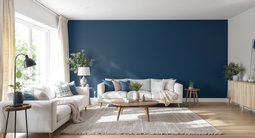TL;DR
Thinking of a navy color-drench or an accent wall? This guide shows how wall paint, wallpaper, wall paneling, wall tiles, exposed brick, and stone veneer affect light, upkeep, and budget—plus simple rules to get proportions right. You’ll learn how to choose wall paint finishes for small spaces and when texture beats color.
Wall Treatments Guide: Paint vs. Wallpaper, Paneling, Tile, and More

Comparing wall paint, wallpaper, wood paneling, and exposed brick shows diverse textures shaping room ambiance.
If wall paint feels boring but a navy color-drench looks risky, you’re not alone. Walls are the biggest surface in any room, so color, pattern, and texture change how light bounces, how sound is absorbed, and how cozy or energetic a space feels. Dramatic shades like deep navy can look lush and modern in bright rooms; in dim spaces, they can tilt moody or cave-like without layered lighting. Designers say the best wall finishes balance three things: mood, maintenance, and money. One homeowner who painted a TV room in inky blue calls it “peaceful and infinite at night.” Another who inherited a navy dining room said it robbed light from the adjoining kitchen. Here’s why this matters: the same color behaves differently with window orientation, bulb temperature, and sheen. This guide compares wallpaper, wall paneling, wall tiles, exposed brick, and stone veneer against interior painting—so you can commit confidently, whether you want a single accent wall or a full, color-drenched envelope.
Core Question: How Do I Choose the Right Wall Treatment?
The right wall treatment depends on room type, humidity, budget, and how permanent you want the change to be. Pick paint for speed and flexibility, wallpaper for pattern and depth, wall tiles for water resistance, wood paneling for warmth, and brick or stone veneer for raw texture. Quick tip: evaluate the walls before you fall for a finish.
- Surface condition: Skim-coat dents and sand glossy paint; primer improves adhesion and color accuracy.
- Light direction: North light cools colors; west light warms. Dark hues need layered lighting to avoid a cave effect.
- Humidity and mess: Baths, kitchens, and mudrooms benefit from semi-gloss paint, vinyl wallpaper, or wall tiles.
- Budget and permanence: Paint is lowest cost and easiest to change; tile and stone are long-haul investments.
Anecdote
A homeowner who color-drenched a home office in navy described it as “calm and cocooning,” but added two lamps to avoid afternoon slump—proof that lighting sells the drama.
Paint & Repaint Strategies
Wall paint is the quickest, most customizable wall treatment, and repainting is the simplest reset. Use undertones, finish sheen, and light reflection to control mood. Here’s why sheen matters: matte hides flaws but absorbs light; eggshell adds gentle bounce for living rooms; semi-gloss resists moisture in baths and kitchens. Painters often recommend flat on ceilings, eggshell on walls, and semi-gloss on trim—even in a single dark color—to keep surfaces reading correctly.
- Rules of thumb: matte = low light hiding power; eggshell = living rooms; semi-gloss = bath/kitchen, doors, trim.
- Coverage: 1 gallon typically covers 350–400 sq ft; two coats over a tinted primer help with deep colors like navy.
- Light: aim for layered lighting—ceiling ambient + 2–3 lamps or sconces per room to keep dark paint feeling intentional.
- Best paint colors for small rooms: lighter mid-tone neutrals with higher LRV (≥ 60) or a jewel-box dark plus bright lamps and pale textiles.
- Color-drenching tip: vary sheens (flat ceiling, eggshell walls, semi-gloss trim) to preserve depth in one hue.
Wallpaper & Fabric Wallcoverings
Wallpaper adds pattern, texture, and personality that paint can’t, from linen weaves to grasscloth to murals. Use vinyl or fabric-backed wallpaper in high-traffic zones; reserve delicate grasscloth for dry, low-touch walls. Rules designers use when ordering wallpaper: measure wall area and add at least 10% extra for pattern match; most repeats run 20–25 inches. Avoid natural fibers in humid rooms and consider peel-and-stick for rentals or commitment-phobes.
- Types: peel-and-stick (renter friendly), vinyl (wipeable), grasscloth (luxurious texture), fabric-backed (durable in halls).
- Preparation: prime with a wallpaper primer for easier removal and smoother seams.
- How to choose wallpaper texture: combine one tactile wall with smoother, painted neighbors to prevent visual noise.
- Preview: use ReimagineHome to test pattern scale on your real walls before you order rolls.
Tiling as a Wall Finish
Wall tiles offer unmatched durability in wet zones and messy spaces. Ceramic and porcelain are the easiest-care choices; glass tiles amplify light; natural stone brings earthy depth but needs sealing. Use the right spacing and height so lines look crisp. Aim for 1/8 inch grout joints for most ceramic wall tiles and 1/16 inch for porcelain; run full-height tile in showers or create a 42-inch wainscot in powder rooms and kitchens.
- Material differences: ceramic is cost-effective; porcelain is denser and lower maintenance; stone needs sealing yearly; glass wants non-sanded grout.
- Maintenance: seal natural stone every 12 months and cement grout as directed; epoxy grout resists stains.
- DIY tiling vs professional tiling cost: expect roughly $10–$25 per sq ft installed for ceramic wall tile; DIY materials can fall near $3–$8 per sq ft.
Visualization Scenario
Upload your living room photo to ReimagineHome, try a navy color-drench with flat ceilings and eggshell walls, then swap in a beadboard wainscot and compare against a 42-inch ceramic wainscot. Toggle grazing lights across a brick veneer to see how texture reads at night.
Wood Paneling & Wainscoting
Wood paneling brings warmth and dimension, from classic beadboard to modern slat walls. Wainscoting protects high-traffic areas and adds architecture without demolition.
- Options: shiplap, beadboard, board-and-batten, slat walls, fluted panels; MDF is stable for paint, solid wood suits stain.
- Heights: traditional wainscot is about one-third of wall height (≈ 32–36 inches); modern feature walls can rise up to two-thirds.
- Panel spacing: keep battens ≤ 2 feet apart for balanced rhythm.
- Finishes: paint for a tailored look; stain to showcase grain and pair with navy or forest green walls.
Exposed Brick & Stone Veneer
Raw texture brings architectural soul to modern interiors and softens glossy furniture. Brick veneer is typically 1/2–1 inch thick; stone veneer averages about 1 1/2 inches.- Maintenance: seal brick or stone and re-seal every 3–5 years; vacuum with a brush attachment between washes.
- Colorwash: limewash or a sheer colorwash mutes orange brick without hiding texture.
- Light it right: wall-graze with warm LEDs to highlight ridges; adjust dimmers to avoid harsh shadows.
- Visualize first: tools like ReimagineHome help compare exposed brick walls vs stone veneer in your actual room before committing.
Mixing Wall Treatments
Balance impact with restraint: one hero wall plus supporting neutrals keeps rooms coherent. A useful ratio is 70% paint, 20% texture, 10% accent.- Accent wall placement: choose the wall you face most, not the shortest one.
- Design psychology: matte reads calm, gloss adds energy, texture feels warm and grounded.
- Palette tip: if you go dark navy, add cream drapery, brass picture frames, and leafy plants to keep lift and contrast.
Maintenance & Longevity
Plan upkeep as part of the budget so finishes age well. Paint typically lasts 3–7 years; quality wallpapers 7–15; tiles and paneling can go decades.- Cleaning: washable paint finishes and vinyl wallpaper wipe with mild soap; maintain exposed brick walls with a pH-neutral cleaner.
- High-traffic walls: semi-gloss or durable scrubbable matte keeps scuffs at bay; chair rails or wainscot take the hits.
- Humid zones: re-caulk and re-seal grout as needed; inspect for peeling edges on wallpaper near steam.
Visualization & Planning
Test combinations digitally before you buy. ReimagineHome lets you try wall paint, wallpaper texture, modern wood paneling ideas, and tile layouts on photos of your own room.- Process: capture daylight and evening photos; compare undertones and sheen; export a palette and shopping list.
- Sampling: paint 24-inch swatches or sample boards; hang wallpaper swatches vertically to judge scale and repeat.
FAQ
- How do I choose between paint and wallpaper? Paint wins for budget and flexibility; wallpaper adds pattern and texture. Use paint in high-wear rooms and wallpaper on focal walls or low-touch zones.
- What wall finish works best in bathrooms? Semi-gloss wall paint or vinyl wallpaper; in showers, wall tiles with 1/8 inch grout for ceramic or 1/16 inch for porcelain. Ventilation is non-negotiable.
- What’s the best paint finish for high-traffic walls? Scrubbable matte or eggshell on walls with semi-gloss on trim. They hide scuffs better while staying easy to clean.
- How can I clean exposed brick without damage? Vacuum with a brush, then spot-clean using a pH-neutral cleaner; re-seal every 3–5 years to repel dust and stains.
- Are wood panels outdated or trending? Wood paneling is trending in modern forms—slat walls, fluted panels, and painted board-and-batten—especially at one-third wall height.
- How much does wall tiling cost per sq ft? For ceramic wall tile, many regions see $10–$25 per sq ft installed; DIY materials can be about $3–$8 per sq ft.
- What are the best paint colors for small rooms? Choose light neutrals with higher LRV for brightness, or go jewel-box dark with layered lighting and pale fabrics for contrast.
Closing Reflection
Walls are the largest canvas in your home, and they tell a story in color, texture, and light. A deep navy can read like velvet in rooms with generous daylight and layered lamps, while pale paint amplifies sunbeams and makes art pop. Texture adds memory: the fine shadow of beadboard, the gloss of glazed tile, the grain of oak slats, the grainy warmth of brick. Choose one hero move—color, pattern, or texture—and let the rest support it. Ready to test your ideas without opening a single can? Upload a photo to ReimagineHome to preview wall paint, wallpaper, wall tiles, wood paneling, exposed brick, or stone veneer side by side. When your room looks right on-screen, it’s far more likely to feel right in real life.
.svg)

.svg)
.jpg)








.png)